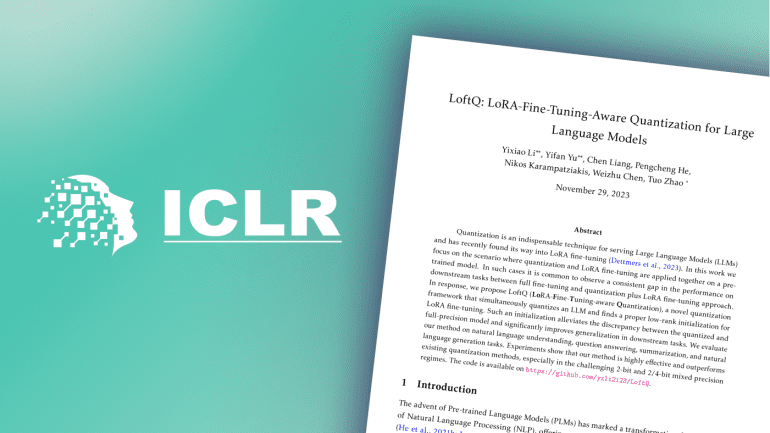- Microsoft introduces LoftQ, a novel technique streamlining LLM fine-tuning.
- LoftQ combines quantization and adaptive initialization for enhanced performance.
- The method reduces memory and computation requirements while preserving accuracy.
- LoftQ’s algorithm optimizes weight simplification and low-rank adaptation.
- Evaluations demonstrate LoftQ’s superiority over existing methods across diverse tasks.
- LoftQ’s applicability extends beyond LLMs to other AI domains like vision and speech technologies.
- LoftQ is available as open source through the Hugging Face PEFT library.
Main AI News:
In the realm of Artificial Intelligence (AI), Large Language Models (LLMs) stand as towering pillars, wielding vast datasets and sophisticated algorithms to weave intricate, context-rich content. Yet, their development demands substantial computational resources, presenting a formidable challenge. Addressing this conundrum head-on, Microsoft unveils LoftQ, a groundbreaking technique poised to redefine the landscape of LLM fine-tuning.
Fine-tuning, a pivotal stage in the evolution of pre-trained language models, involves honing them to excel in specialized domains, like medical document analysis. Here, LoftQ emerges as a beacon of innovation, streamlining the fine-tuning process for heightened performance. Leveraging LoftQ yields a spectrum of enhancements: from sharper predictions and deeper comprehension of domain-specific vernacular to more contextually relevant responses within specialized domains.
The cornerstone of LoftQ’s prowess lies in its fusion of quantization and adaptive initialization during fine-tuning. Quantization, a technique that truncates model parameters, slashes memory and computation requirements, ushering in accelerated processing and reduced power consumption. Meanwhile, adaptive initialization meticulously aligns model parameters with their optimal pre-trained state, ensuring maximal efficiency while minimizing resource utilization. The intricacies of this method are meticulously elucidated in Microsoft’s paper, “LoftQ: LoRA-Fine-Tuning-Aware Quantization for Large Language Models,” presented at ICLR 2024.
The Mechanics of LoftQ
LoftQ stands on the shoulders of two foundational principles: LoRA and QLoRA. LoRA, a pioneering method, drastically curtails parameter count during training, thereby diminishing memory prerequisites for fine-tuning. QLoRA, on the other hand, employs 4-bit quantized, frozen weights, and low-rank adapters, further slashing memory overhead while upholding peak performance.
A comparative analysis showcased in Table 1 underscores the efficacy of LoftQ. While LoRA achieves a fourfold reduction in memory usage, QLoRA, with its nuanced approach, attains an additional twofold reduction. However, QLoRA entails a tradeoff, where some quality of the pre-trained model is compromised due to weight quantization. Enter LoftQ, which deftly navigates this tradeoff by optimizing the initialization of quantization and low-rank adaptation matrices, ensuring a symbiotic balance between efficiency and performance.
The LoftQ algorithm operates through a dual-step process: initially quantizing the weights, followed by identifying optimal low-rank factors that closely approximate the quantization vis-à-vis the pretrained weights. This iterative approach culminates in a more effective initial state for fine-tuning, preserving accuracy while significantly simplifying weights and conserving computational resources.
Evaluating LoftQ
Comprehensive evaluations across diverse LLM variants, including the Llama-2 model family, underscore LoftQ’s consistent delivery of robust performance, oftentimes eclipsing configurations with QLoRA. Practical assessments, as delineated in Table 2, demonstrate LoftQ’s efficacy across varied tasks, from minimizing perplexity on the WikiText-2 dataset to enhancing problem-solving capabilities on the GSM8K dataset.
LoftQ’s promise transcends the confines of LLMs, extending its transformative potential to other AI domains like vision and speech technologies. As research advances, Microsoft remains steadfast in its commitment to further enhancements, poised to elevate performance across downstream tasks and foster broader adoption across AI applications.
Empowering the AI Community
LoftQ stands as a testament to Microsoft’s unwavering dedication to advancing AI research and fostering sustainable development. Available as open source through the Hugging Face PEFT library, LoftQ invites the AI community to embark on a journey of exploration, harnessing its transformative power to usher in a new era of efficiency, performance, and innovation. With LoftQ, the horizon of AI is ablaze with possibilities, beckoning researchers and practitioners alike to chart new frontiers of discovery and progress.
Conclusion:
Microsoft’s LoftQ represents a significant advancement in the field of AI, particularly in the realm of LLM fine-tuning. By effectively reducing memory and computation requirements while maintaining or even enhancing performance, LoftQ sets a new standard for efficiency in AI model optimization. Its applicability across various AI domains further underscores its transformative potential, promising to catalyze innovation and accelerate the development of cutting-edge AI solutions. As LoftQ becomes more widely adopted, it is poised to reshape the AI market landscape, driving greater efficiency, sustainability, and performance across a myriad of applications.

